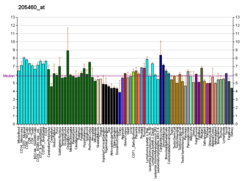In the brain
The NPAS2 protein is a member of the basic helix-loop-helix (bHLH)-PAS transcription factor family and is expressed in the SCN. NPAS2 is a PAS domain-containing protein, which binds other proteins via their own protein-protein (PAS) binding domains. Like its paralogue, CLOCK (another PAS domain-containing protein), the NPAS2 protein can dimerize with the BMAL1 protein and engage in a transcription/translation negative feedback loop (TTFL) to activate transcription of the mammalian Per and Cry core clock genes. [8] NPAS2 has been shown to form a heterodimer with BMAL1 in both the brain and in cell lines, suggesting its similarity in function to the CLOCK protein in this TTFL.
Compensation is a key feature of TTFLs that regulate circadian rhythms. BMAL1 compensates for CLOCK in that if CLOCK is absent, BMAL1 will upregulate to maintain the mammalian circadian rhythms. NPAS2 has been shown to be analogous to the function of CLOCK in CLOCK-deficient mice. [8] In Clock knockout mice, NPAS2 is upregulated to keep the rhythms intact. [8] Npas2-mutant mice, which do not express functional NPAS2 protein, still maintain robust circadian rhythms in locomotion. However, like CLOCK-deficient mice in the CLOCK/BMAL1 TTFL, Npas2-mutant mice (in the NPAS2/BMAL1 TTFL) still have small defects in their circadian rhythms such as a shortened circadian period and an altered response to changes in the typical light-dark cycle. [8] In addition, Npas2 knockout mice show sleep disturbances and have decreased expression of mPer2 in their forebrains. [13] Mice without functional alleles of both Clock and Npas2 became arrhythmic once placed in constant darkness, suggesting that both genes have overlapping roles in maintaining circadian rhythms. In both wild-type and Clock knockout mice, Npas2 expression is observed at the same levels, confirming that Npas2 plays a role in maintaining these rhythms in the absence of Clock. [8]
In other tissues
Npas2 is expressed everywhere in the periphery of the body. Special focus has been given to its function in liver tissues, and its mRNA is upregulated in Clock-mutant mice. However, studies have shown that Npas2 alone is unable to maintain circadian rhythms in peripheral tissues in the absence of CLOCK protein, unlike in the SCN. [8] One theory to explain this observation is that neurons in the brain are characterized by intercellular coupling and can thus respond to deficiencies in key clock proteins in nearby neurons to maintain rhythms. In peripheral tissues such as the liver and lung, however, the lack of intercellular coupling does not allow for this compensatory mechanism to occur. A second theory as to why NPAS2 can maintain rhythms in CLOCK-deficient SCNs but not in CLOCK-deficient peripheral tissues, is that there exists an additional unknown factor in the SCN that is not present in peripheral tissues. [8]






